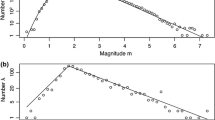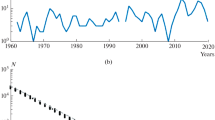Abstract
This paper presents the results of analysis of the spatial distribution of repeated shocks. Data from the world earthquake catalog of USGS/NEIC from 1973 to 2014 were used. Short time intervals, no more than 10 hours after the main shock, and distances from the epicenter of the main shock, no more than 5°, were considered. The dependence of the number of repeated shocks on the distance from the epicenter was studied. Two properties of the spatial distribution of repeated shocks have been identified. The first property is that the curve describing spatial distribution has its maximum at a certain distance (approximately from 10 to 120 km) from the epicenter of the main shock. The logarithm of this distance is directly proportional to the magnitude of the main shock. The second property is that the position of the maximum does not depend on time, i.e., it is a stable spatial characteristic of the earthquake source. Based on these properties, a new way to determine the size of the rupture zone was proposed.





Similar content being viewed by others
REFERENCES
Bonilla, M.G., Mark, R.K., and Lienkaemper, J.J., Statistical relations among earthquake magnitude, surface rupture length, and surface fault displacement, Bull. Seism. Soc. Am., 1984, vol. 74, no. 6, pp. 2379–2411.
Darragh, R.B. and Bolt, B.A., A comment on the statistical regression relation between earthquake magnitude and fault rupture length, Bull. Seism. Soc. Am., 1987, vol. 77, no. 4, pp. 1479–1484.
Dowrick, D.J., Relations between earthquake magnitude and fault rupture dimensions: how regionally variable are they? Bull. Seismol. Soc. Am., 2004, vol. 94, no. 3, pp. 776–788.
Henry, C. and Das, S., Aftershock zones of large shallow earthquakes: fault dimensions, aftershock area expansion and scaling relations, Geophys. J. Int., 2001, vol. 147, pp. 272–293.
Homma, S. and Seki, A., A relation between the area of aftershock region and the radius of the sensibility circle (continued), Zisin (J. Seism. Soc. Jap.) II, 1951, vol. 3, pp. 44–48 (in Japanese with English summary).
Leonard, M., Self-consistent earthquake fault-scaling relations: Update and extension to stable continental strike-slip faults, Bull. Seism. Soc. Am., 2014, vol. 104(6), pp. 2953–2965.
Lunina, O.V., The influence of stress in the lithosphere on the relationships between seismogenic fault parameters and earthquake magnitude, Geol. Geofiz., 2001, no. 9, pp. 1389–1398.
Purcaru, G. and Berckhemer, H., Quantitative relations of seismic source parameters and a classification of earthquakes, Tectonophysics, 1982, vol. 84, pp. 57–128.
Riznichenko, Yu.V., The source dimensions of the crustal earthquakes and the seismic moment, in Issledovaniya po fizike zemletryasenii (Studies in Earthquake Physics), Moscow: Nauka, 1976, pp. 9–27.
Rodkin, M.V., On the regime of seismic activation in the generalized vicinity of the large earthquake, Fizicheskaya Mezomekhanika, 2008a, vol. 11, no. 1, pp. 74–79.
Rodkin, M.V., Seismicity in the generalized vicinity of large earthquakes, J. Volcanol. Seismol., 2008b, vol. 2, no. 6, pp. 435–445.
Ryal, A., Douglas, B.M., Melon, S.D., and Savage, W.I., The use of microearthquakes for determining the mechanism of stress release and elastic characteristics of earthquake sources in Nevada, Izv. AN SSSR, Fizika Zemli, 1972. no. 12, pp. 12–24.
Seki, A. and Homma, S., A relation between the area of aftershock region and the radius of the sensibility circle, Zisin (J. Seism. Soc. Jap.), II, 1949, vol. 2, p. 37–40 (in Japanese with English summary).
Strom, A.L., On relationships between parameters of discontinuities and earthquake magnitude, in Obshchemoskovskii Tektonofizicheskii Seminar, Personal communication, Moscow: IFZ RAN, 2014. http://www.ifz.ru/novosti/?tx_ttnews%5Btt_news%5D= 705&cHash=eeba62e91a7e6495f44c6174a0849398
Utsu, T. and Seki, A., A relation between the area of aftershock region and the energy of main shock, Zisin (J. Seism. Soc. Jap.), II, 1955, vol. 7(4), pp. 233–240.
Vakov, A.V., Relationships between magnitude and source dimension for earthquakes showing different types of slip, Sbornik Nauchn. Trudov Gidroproekta, 1988, no. 130, pp. 55–69.
Vikulin, A.V., Fizika volnovogo seismicheskogo protsessa (Physics of the Seismic Wave Process), Petropavlovsk-Kamchatsky: KOMSP GS RAN, 2003.
Vikulin, A.V., Fizika Zemli i geodinamika (Physics of the Earth and Geodynamics), a handbook for geophysicists, Petropavlovsk-Kamchatsky: KAMGU Im. Vitusa Beringa, 2008.
Wells, D.L. and Coppersmith, K.J., New empirical relationships among magnitude, rupture length, rupture width, rupture area, and surface displacement, Bull. Seismol. Soc. Am., 1994, vol. 84, no. 4, pp. 974–1002.
Zotov, O.D., Zavyalov, A.D., Guglielmi, A.V., and Lavrov, I.P., Space–time patterns in aftershock evolution, in Materialy 4-oi Vserossiiskoi konferentsii c mezhdunarodnym uchastiem “Triggernye effekty v geosistemakh” (Proc. 4th All-Russia Conference with international participation “Trigger Effects in Geosystems”), Adushkin, V.V. and Kocharyan, G.G., Eds., Moscow: GEOS, IDG RAN, 2017, pp. 121–126.
ACKNOWLEDGMENTS
We express our gratitude to A.V. Guglielmi and B.I. Klain for many helpful discussions.
Funding
This work was carried out with partial financial support from the Russian Foundation for Basic Research (project no. 18-05-00096), as well as the State Task Programs of the Schmidt Institute of Physics of the Earth RAS.
Author information
Authors and Affiliations
Corresponding authors
Rights and permissions
About this article
Cite this article
Zavyalov, A.D., Zotov, O.D. A New Way to Determine the Characteristic Size of the Source Zone. J. Volcanolog. Seismol. 15, 19–25 (2021). https://doi.org/10.1134/S0742046321010139
Received:
Revised:
Accepted:
Published:
Issue Date:
DOI: https://doi.org/10.1134/S0742046321010139




